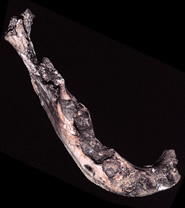Social conscience came early

Toothless survival needed a helping hand. <br>© E. Trinkaus
New-found jawbone hints at 200 thousand years of care in the community.
Care for the elderly and disabled may have been around a lot longer than we thought. The discovery of a jawbone scarred by severe gum disease hints that a toothless early human got by with a little help from his friends.
Minus teeth, unable to chew his or her food, the owner of the deformed jawbone nonetheless survived “for at least several months,” estimates anthropologist Erik Trinkaus of Washington University in St. Louis, Missouri. Chewing had worn the bone that had re-grown to fill the tooth sockets1.
“This individual was preferentially getting the soft bits [of food] or was getting help,” says Trinkaus. His research team discovered the mandible in France.
This level of social awareness was thought to have originated about 50 thousand years ago among our thickset cousins the Neanderthals. The jawbone pushes the date for collaborative survival way back – about 175 and 200 thousand years ago.
“It suggests pre-Neanderthals had significant elements of fully human behaviour,” says Chris Stringer an archaeologist at the Natural History Museum in London, UK. But it doesn’t tell us exactly when caring for other group members first evolved.
Until recently the social sophistication needed for group members to care one another was thought to have arisen with our direct ancestors, the early modern humans. Discoveries of elderly and diseased Neanderthals showed that they were looking out for each other around 50,000 years ago.
Markings on worn teeth from the same site suggest that pre-Neanderthals, like their Neanderthal descendants, were particularly dependent on their teeth for survival, using them to scrape off meat and crush bones. The lack of stone tools and other technology make it unlikely that a toothless individual could have processed food in any other way, says Trinkaus.
While sociable, there’s no evidence that our common ancestors, primates, care for sick or disabled members of their social groups. Studies indicate that they starve after losing their teeth, according to Trinkaus.
Media Contact
All latest news from the category: Life Sciences and Chemistry
Articles and reports from the Life Sciences and chemistry area deal with applied and basic research into modern biology, chemistry and human medicine.
Valuable information can be found on a range of life sciences fields including bacteriology, biochemistry, bionics, bioinformatics, biophysics, biotechnology, genetics, geobotany, human biology, marine biology, microbiology, molecular biology, cellular biology, zoology, bioinorganic chemistry, microchemistry and environmental chemistry.
Newest articles

Webb captures top of iconic horsehead nebula in unprecedented detail
NASA’s James Webb Space Telescope has captured the sharpest infrared images to date of a zoomed-in portion of one of the most distinctive objects in our skies, the Horsehead Nebula….

Cost-effective, high-capacity, and cyclable lithium-ion battery cathodes
Charge-recharge cycling of lithium-superrich iron oxide, a cost-effective and high-capacity cathode for new-generation lithium-ion batteries, can be greatly improved by doping with readily available mineral elements. The energy capacity and…

Novel genetic plant regeneration approach
…without the application of phytohormones. Researchers develop a novel plant regeneration approach by modulating the expression of genes that control plant cell differentiation. For ages now, plants have been the…





















